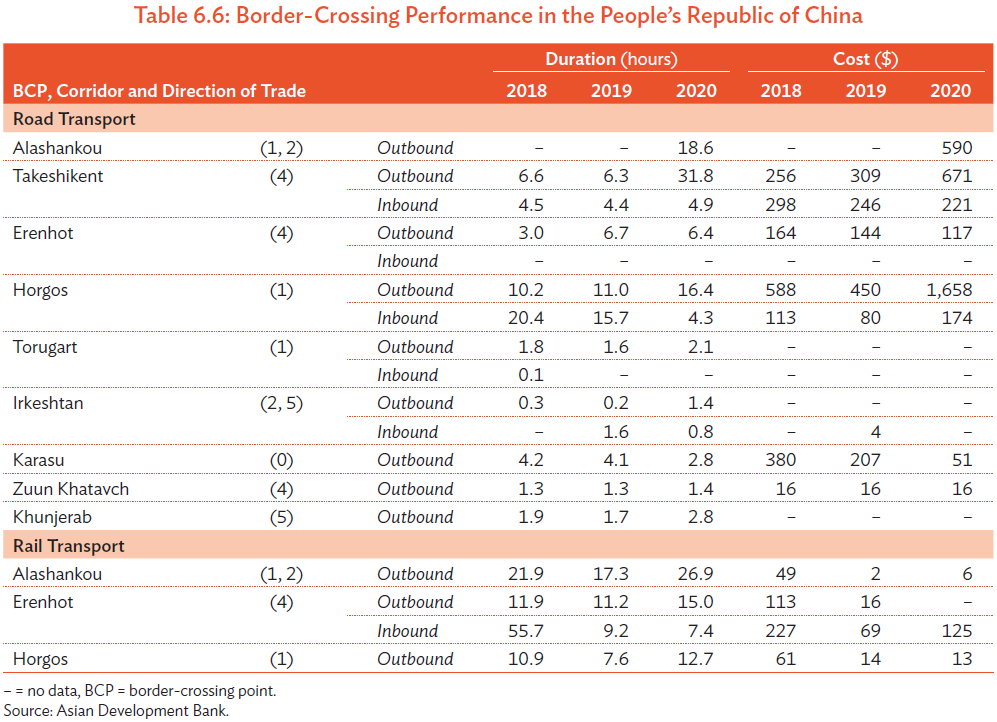The CPMM analysis relies on consistent and comparable data across CAREC countries, despite their inherent differences. This chapter provides an update of the main developments and CPMM data at a national level for each CAREC member country to help explain the trends or resulting outcomes at the regional or corridor level. This country-level analysis examines the policies, regulations, infrastructure, and institutional factors that can affect corridor performance. Pertinent barriers and issues are highlighted, key developments and progress are noted, and high-level recommendations are included.
The 2020 CPMM report introduces the four TFIs at the country level, segregated by road and rail transport, and further separated into outbound and inbound direction for border-crossing time and costs (Tables 6.1–6.22). These data are supplemented by average border-crossing time and cost for BCPs along relevant CAREC corridors. Key CPMM findings, updated trends and developments, and country-specific recommendations are also provided in this chapter.
Key Findings
- In 2020, both border-crossing duration and costs increased rather substantially in the PRC. Both road and rail transports were affected due to additional inspection and sanitation controls, but roads suffered to a greater degree due to shutting down of road BCPs, while rail freight continued.
- For road transport, border-crossing time averaged 7.1 hours in 2020, up from 4.3 hours in 2019. Border-crossing cost surged from $166 in 2019 to $424 in 2020. Total transport cost increased from $1,257 to $1,710.
- SWOD increased from 69.8 km/h to 82.0 km/h, and SWD increased from 25.9 km/h to 47.2 km/h.
- Outbound shipments at Takeshikent reported the longest duration (31.8 hours), followed by Horgos (16.4 hours). Fees at Horgos surged four times to $1,658 in 2020 due to the need to segregate driver, cargo, and material handling equipment, which drove up the total transport cost. Interestingly, trucks moved at 82 km/h in 2020, much higher than the 69.8 km/h in 2019 as there were less queues at BCPs and vehicles on road due to the pandemic. It remains to be seen if this could extend into 2021 as trade volume normalizes.
- For rail transport, border-crossing time increased from 13.4 hours in 2019 to 18.3 hours in 2020. Border-crossing cost increased from $104 in 2019 to $115 in 2020. Total transport cost dipped from $789 in 2019 to $678 in 2020. Comparing 2019 and 2020, SWOD changed from 65.1 km/h to 62.5 km/h, and SWD decreased from 20.9 km/h to 16.8 km/h.
- Rail BCPs such as Alashankou, Erenhot, and Horgos all reported increased border-crossing times. The situation is more serious at Alashankou where average delay was estimated at 26.9 hours in In October 2020, Kazakhstan shippers reported long queues developing at Alashankou when the Chinese authorities imposed more stringent sanitation controls on all incoming goods that were transported in conventional wagons, which were subjected to physical examinations. Containerized shipment passed through without much problem on the other hand, which led to increasing interest from the Kazakhstan shippers to consider using a container for exporting to the PRC.
Trends and Developments
When news of COVID-19 circulated in early 2020, many countries promptly closed their borders with the PRC. Subsequently, trailer or cargo transfer at “neutral zones” was implemented as the PRC trucks could not enter the neighboring country and vice versa. This new arrangement caused border delays. A consequence of COVID-19 was the increased time to consolidate cargoes. Compounded by the closure of many companies and logistics centers, moving freight out in the first half of 2020 was extremely challenging.
Nevertheless, the PRC made notable strides in TIR implementation. The estimated freight rate of a TIR shipment was $1,300 per 500 km, compared to $500 per 500 km on a container express train from the PRC to Europe—although the higher charge is justified as operators provide a faster, more reliable service, with drivers guarding high-value cargo, and trucks have higher cubic capacity compared to 40-foot containers in express container trains.
Rail transport was a vital link that enabled trade in 2020 even when road and air transports were closed. Toward the end of 2020, the average outbound border-crossing time at Alashankou increased sharply from 25.0 hours in October, to 38.5 hours in November, and 48.2 hours in December, nearly doubling in 2 months. This long time was due to heavy congestion at the BCPs due to (i) diversion from ocean to rail, caused by surge in ocean rates and scarcity in vessel space; and (ii) the adoption of stricter control of COVID-19 in the PRC as winter approached and a resurgence of infection was anticipated. Inspection and quarantine of materials led to a reduced throughput at Alashankou and Horgos. Consequently, freight started to accumulate at stations such as Lanzhou and Xi’an as China Railways instituted periodic embargos. Container express trains, being accorded higher priority, were relatively unaffected by this measure. Conventional freight trains, on the other hand, suffered as the queue lengthened.


Recommendations
- Relieve the border delays and high cost at road border-crossing points. In 2020, border-crossing through road BCPs such as Horgos–Nur Zholy became very cumbersome due to procedural constraints in light of the COVID-19 outbreak. To minimize spread of the COVID-19 virus, Kazakhstan trucks were no longer permitted to enter Chinese bonded warehouses to pick up goods. Transfer of materials was done at a “no man’s land” between the border, with the forklifts and shuttle vehicles deployed between the bonded warehouses and the “no man’s land.” This added significantly to the border-crossing cost, where samples showed numerous shipments incurred more than $6,000 in one trip due to these additional loading and unloading, temporary warehouse storage and materials transfer. While necessary to control possible infection, this action is not sustainable. Border authorities from the PRC and the adjacent countries should hold bilateral talks and explore initiatives that ease the situation, such as the use of special COVID-19 green lanes to expedite border-crossings.
- Streamline COVID-19 border inspection at rail border-crossing points. Long queues of wagons and trains were held up at Alashankou–Dostyk and Horgos–Altynkol due to capacity constraints. The additional package-by-package inspection mandated by the Xinjiang Uygur Autonomous Region border agencies affected the throughput at the rail BCPs. With the increased traffic diverted from sea to rail, this problem would be aggravated and if unresolved, would lead to spoilage of perishables such as grains and oilseeds. Border authorities from the PRC and the adjacent countries may hold bilateral talks and explore initiatives that ease the situation. Measures used to expedite express container trains should be considered for regular trains.
- Expand the transload capacity at Alashankou and Horgos. A key reason for rail interchange delays at the PRC–KAZ border is the necessity to transfer cargo between rail systems using different gauges. To do so requires side-by-side transloading tracks at both Dostyk (for incoming trains from the PRC) and Alashankou (for incoming trains from KAZ). Due to robust growth of cross-border traffic, congestions emerged at both rail stations, which were built decades ago when the traffic flow was much lower. The PRC and KAZ governments should examine means to expand the transloading capacity at both Alashankou and Dostyk by expanding yard space; adding more transloading tracks; replacing outdated container handling cranes with high-speed cranes guided by global positioning systems (GPS); and streamlining operating procedures.
- Shift some cargo transloading from Dostyk to Alashankou. Due to its location bounded by mountains, Dostyk station has limited options for expansion. On the other hand, Alashankou is much better situated for yard expansion and China Railways have resources to do so. China Railways and Kazakhstan Temir Zholy could consider modifying the Organization for Cooperation of Railways (OSJD) protocol so Alashankou can handle cargo transloading into Russian gauge wagons when Dostyk is swamped with work.
